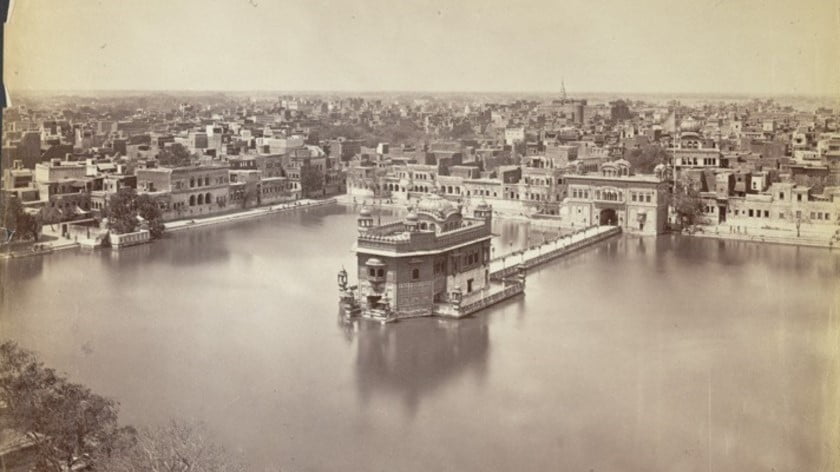India Just Revealed How Scared It Is of Khalistan
India is politicizing the Kartarpur Corridor by its demand that Pakistan prevent nationalist Sikhs from sharing their pro-Khalistan sentiment with pilgrims along the route, which reveals just how scared it is of this national liberation movement and the potentially far-reaching domestic political consequences of its revolutionary Anandpur Sahib Resolution if that 1973 manifesto ever enjoys a resurgence of popularity.
The Kartarpur Corridor
India media reported that their country’s officials recently complained to Pakistan about the pro-Khalistan activities that are supposedly taking place on its side of the border, demanding that their neighbor prevent them from occurring along the Kartarpur Corridor that the two are presently negotiating to open before the 550th birth anniversary of Baba Guru Nanak in November. The Gurdwara Darbar Sahib Kartarpur sits just across the border in Pakistan from India’s majority-Sikh state of Punjab and is revered by this religion’s adherents as the site of their founder’s final resting place, hence why PM Khan prioritized the creation of this visa-free corridor immediately after he took office last August in advance of this hugely symbolic upcoming anniversary. India is very concerned, however, that its Sikh minority will be exposed to the separatist sentiments expressed by the Khalistani national liberation movement during their pilgrimages on Pakistani territory, and it’s deathly afraid that millions of this demographic could therefore feel emboldened to give this cause a fresh impetus once they return home and consequently pose a serious challenge to the state.
The Khalistan Movement
Relations between the Sikhs and the central government haven’t been good after former Prime Minister Indira Gandhi ordered the 1984 “Operation Blue Star” massive military assault on the Harmandir Sahib in response to leaders of the Khalistan movement seeking refuge there two years prior. Two of the Indian leader’s Sikh bodyguards assassinated her by the end of the year as revenge for the bloodshed that she brought upon their people in one of their holiest sites, which briefly triggered anti-Sikh pogroms all across the country. Those events, more so than any others, inspired many Sikhs to support outright Khalistani separatism instead of the autonomous goals originally laid out in the revolutionary Anandpur Sahib Resolution of 1973. The far-reaching domestic political significance of that document will be returned to shortly in this analysis, but at this moment it’s enough to recognize that the Khalistani cause itself initially started out as a states-rights movement advocating constitutional reform and didn’t begin to popularly take on its contemporary separatist character until after “Operation Blue Star” forever ruined what little trust remained up until that point between the Sikhs and the central government.
Two Sets Of Concerns
India officially downplays the support that the Khalistani cause has among the millions of Sikhs in its territory, but its politicized concerns that Pakistan won’t prevent pro-Khalistani activities from taking place along this route reveal just how scared it really is of this national liberation movement and strongly suggest that the members of its religious minority are much more sympathetic to that cause that New Delhi cares to publicly admit. From a military perspective, the “nightmare scenario” of a second rebellion along India’s sensitive western borderlands would complement the ongoing one in Kashmir and make it much more difficult for the country’s armed forces to confidently maintain a credible forward-operating posture against Pakistan if they’re forced to also confront the possibility of behind-the-lines attacks by Khalistani separatists in the event of another conventional conflict with their neighbor. While this factor certainly shouldn’t be underestimated, it’s more so the nationwide political strategic impact of the Khalistani cause as enshrined in the 1973 Anandpur Sahib Resolution that India fears the most.
A Revolutionary Manifesto
That revolutionary manifesto is significant in this context because it advocates sweeping administrative-territorial reform on the basis of a fully federalized state whose newly created units would more accurately represent the country’s linguistic, cultural, and religious diversity than the imperfect framework implemented by the 1956 States Reorganization Act that relied mostly on the creation of large states around the linguistic majority of a given region. In pursuit of their State of Khalistan, activists sought to incorporate the Sikh areas of neighboring states into their proposed political entity, “thus bringing main contiguous Sikh population and Sikh habitats with this autonomous Sikh region as an integral part of the Union of India.” This “irredentist” vision mirrors that of the Nagas on the complete opposite side of the country who want all Naga-inhabited areas under the jurisdiction of what they call Nagalim, which recent reports from Northeastern India indicate might have been secretly agreed to by New Delhi as part of the mysterious 2015 framework agreement that it clinched with a rebel faction and whose details have yet to be revealed.
Eastern Concessions Might Trigger A Western Reaction
In the event that New Delhi concedes to the Nagas’ demand for Nagalim, even if only in the sense of establishing a pan-Naga cultural body in the Naga-inhabited areas of the neighboring states instead of formally revising regional borders and risking a geopolitical explosion in the “Indian Balkans“, then it would automatically trigger a reaction in Khalistan. The authorities are evidently trying to prevent that scenario from transpiring by doing their utmost to pressure Pakistan to ensure that India’s Sikh pilgrims aren’t exposed to pro-Khalistan sentiment while traveling along the Kartarpur Corridor, but the proverbially cat has been out of the bag for three and a half decades already since “Operation Blue Star” heralded the point of no return in the Sikhs’ relations with the central government. That doesn’t necessarily mean that all supporters of the Khalistani national liberation movement are in favor of separatism, but just that the basis of their cause as elaborated in the 1973 Anandpur Sahib Resolution could predictably enjoy a resurgence of popular support if New Delhi gives the Nagas some form of Nagalim, which could also inspire other minorities in the country to rise up as well.
Another Issue Of Global Renown?
This strategic risk assessment isn’t just speculation but is backed up by none other than the Indian Defence Ministry’s latest report about the global success that Pakistan has had over the past year under PM Khan’s leadership in raising awareness about the Kashmiri cause. It’s therefore not inconceivable that the Khalistani one could soon enjoy similar success as a result of the emerging relationship between Nagalim and the Kartarpur Corridor, which would naturally also bring worldwide attention to the Anandpur Sahib Resolution’s federalist vision of administrative-territorial reform. The Indian government has been doing everything in its power to keep its many minorities in the dark about that political proposal because it’s afraid that this suggested power-sharing arrangement would eventually encourage outright separatism if it ever came to pass, to say nothing of weakening the current Hindutva authorities’ influence over states outside of the their traditional bastion of support in the “Hindi/Cow Belt”, but New Delhi wouldn’t be able to maintain its policy of censorship if that manifesto achieved as much global renown as the Kashmiri cause.
An Alternative Model For Shaping India’s Future
There’s no way that India could stop its many minorities from becoming aware of this decentralized and more democratic alternative to the country’s current centralized fascism if the Anandpur Sahib Resolution’s political vision went viral on social media as a result of a new worldwide awareness campaign modeled off of the successful Kashmiri one. This could be especially impactful in the domestic political sense if it occurs ahead of what seems poised to be the country’s large-scale social disruption in the next decade caused by its looming agricultural crisis, during which time identity conflicts might predictably explode given the socio-political and economic dynamics typically associated with transformational scenarios of that sort. The current authorities are already doing all they can to snuff out secular and minority-led political forces in the country as part of their quest to create the Hindu Rashtra of Akhand Bharat by that time, but these two main obstacles to their goal could present a much more serious challenge if they merged and presented a forward-looking alternative vision inspired by the decentralized and democratic principles enshrined in the Anandpur Sahib Resolution.
Concluding Thoughts
In view of everything that’s been touched upon in this analysis, India’s fear of Khalistan stems more from the domestic political consequences that the widespread popularization of this national liberation movement’s revolutionary Anandpur Sahib Resolution could have than the military implications pertaining to the possible creation of an independent state. There are many more sympathizers of the Khalistani cause in the Indian state of Punjab than New Delhi will admit, which is why it’s so concerned that the possible pilgrimage of millions of this region’s majority-Sikh inhabitants to Pakistan via the Kartarpur Corridor will expose this strategically located minority to separatist sentiment that will in turn embolden them to give a fresh impetus to the cause upon their return home. New Delhi’s reported concessions regarding Nagalim could trigger a Khalistani reaction if/when they’re made public, which might realistically help that latter cause receive as much global renown as the neighboring Kashmiri one. In that scenario, the resurgence in popularity that its 1973 manifesto might have could finally give secular and minority-led forces an alternative vision for challenging the state’s Hindutva one.
By Andrew Korybko
Source: Eurasia Future







